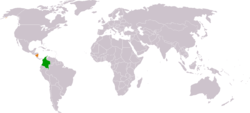- Colombia–Nicaragua relations
-
Colombia-Nicaragua relations 

Colombia
NicaraguaColombia–Nicaragua relations entail the diplomatic relations between the Republic of Colombia and the Republic of Nicaragua. The relationship between the two Latin American countries has evolved amid conflicts over the San Andrés y Providencia Islands located in the Caribbean sea close to the Nicaraguan shoreline and the maritime boundaries covering 150,000 km² that included the islands of San Andrés, Providencia and Santa Catalina and the banks of Roncador, Serrana, Serranilla and Quitasueño as well as the 82nd meridian west which Colombia claims as a border but which the International Court has sided with Nicaragua in disavowing.[1][dead link] The archipelago has been under Colombian control since 1931 when a treaty was signed during US occupation of Nicaragua[citation needed], giving Colombia control over the islands.
Contents
History
See also: Timeline of Colombia–Nicaragua relationsWar in Central America
In 1985 during the Sandinist revolution in Nicaragua, Colombia headed by President Belisario Betancur was part of the Contadora Group along Panama, Mexico and Venezuela. The United Nations supported group intended to promote peace in El Salvador, Nicaragua and Guatemala, which were engulfed in internal armed conflicts.[2]
San Andres archipelago and maritime dispute
Colombia considered that the Esguerra-Bárcenas treaty signed between 1928 and 1930 supported their claim on the sovereignty over the islands.[3]
Nicaragua considered the Esguerra-Bárcenas treaty invalid and argued that at the time it was signed, Nicaragua was invaded by the United States. It also appealed to the Pact of Bogota of 1948, under article 31 of which both countries agreed to comply with the International Court of Justice (ICJ). Colombia considers this pact as invalid since article 6 in the same document specifies that the pact would not apply to previously resolved disputes referring to the Esguerra-Bárcenas treaty.[3]
International Court of Justice case
On December 6, 2001 Nicaragua filed a complaint against Colombia at the International Court of Justice (ICJ) in an attempt to resolve the dispute.[4]
President of Nicaragua Daniel Ortega also claimed that Colombia was too far from San Andres to have sovereignty over these and also accused Colombia of being "imperialist" and "expansionist". On December 12, 2007 Ortega also ordered the Nicaraguan military to be prepared for conflict with Colombia.[5] The Colombian government answered that they would wait for the ICJ resolution and were going to ignore Ortega.
On December 13, 2007 the International Court of Justice was set to resolve at 10 AM.[6] The court finally concluded the long time dispute in favor of Colombia over the sovereignty over the San Andres Archipelago but also said that it had jurisdiction over the other aspects of the maritime dispute.[7]
Unresolved maritime dispute
The Colombian newspaper El Espectador said that Nicaragua could gain territory in this way by setting a new trial to resolve the maritime booundaries that were not previously established in any of the accords or treaties and the Roncador, Quitasueño y Serrana banks. Regarding this Colombia used as border the 82° meridian while Nicaragua wants to expand and gain territory.[8]
President of Colombia Álvaro Uribe and Minister of Foreign Affairs Fernando Araújo expressed that Colombia needs to prove that the banks are also part of Colombia. President Uribe said that at the moment the Esguerra-Bárcenas treaty was signed there was nothing stipulated about the banks because Colombia was contesting them with the United States to resolve the sovereignty over these, but not because Nicaragua was claiming these and pointed out that Colombia had already been generous to Nicaragua by ceding the Mosquito Coast which had been previously claimed by Colombia.[9]
Ortega's humanitarian exchange remarks
On December 14, 2007, President Ortega of Nicaragua stirred controversy after making remarks over the Humanitarian exchange process the Colombian government and the FARC guerrilla are undergoing to exchange hostages for prisoners. Ortega opined about the issue calling the FARC "brothers" to free political prisoner Ingrid Betancourt and said that Betancourt's death could be used to cast blame on the FARC.[10]
The Colombian government regarded these remarks as an intervention in internal Colombian affairs and issued a note of protest to Nicaragua. The Colombian government did not consider appropriate the "familiarized language" used to refer to the head of a "narcoterrorist organization".[11]
See also
References
- ^ LA Times: Border tensions rise in Central & South America
- ^ "1985 - El Grupo de Contadora" (in Spanish). UNESCO. June 10, 2003. http://portal.unesco.org/culture/es/ev.php-URL_ID=9374&URL_DO=DO_TOPIC&URL_SECTION=201.html. Retrieved 2007-12-15.
- ^ a b (Spanish) El Espectador: La Haya decide su jurisdicción en lío de isla de San Andrés
- ^ IOC UNESCO: Nicaragua Sues Colombia before the World Court over a dispute concerning territorial questions and maritime delimitation in the western Caribbean
- ^ (Spanish) Revista Semana: Nicaragua espera el fallo de La Haya sobre San Andrés acusando a Colombia de “imperialista” y “expansionista”
- ^ International Court of Justice: Colombia-Nicaragua case
- ^ International Court of Justice: Colombia-Nicaragua case resolution
- ^ (Spanish) El Espectador: Colombia podría perder territorio, a pesar del fallo de la Haya
- ^ (Spanish) El Espectador: Colombia ratificará soberanía sobre cayos de San Andrés
- ^ (Spanish) El Tiempo: Presidente de Nicaragua pide a sus "hermanos de las Farc" liberar a Ingrid Betancourt. El Tiempo, accessed November 14, 2007.
- ^ (Spanish) El Pais: Colombia protesta por declaraciones de Ortega
External links
- Envio: Roots of the Colombia-Nicaragua Territorial Dispute
- ICJ Nicaragua v. Colombia (Preliminary Objections) and (Merits) and 2007 Preliminary Objections Judgment and ASIL and BBC and Colombia President and Colombia MFA and Analysis 20 Hague YIL 75-119 2008
 Foreign relations of Nicaragua
Foreign relations of NicaraguaBilateral relations Abkhazia · Argentina · Colombia · Denmark · Finland · Guatemala · Russia · South Ossetia · Republic of Texas (historical) · United States Categories:
Categories:- Bilateral relations of Colombia
- Bilateral relations of Nicaragua
- Colombia–Nicaragua relations
Wikimedia Foundation. 2010.

